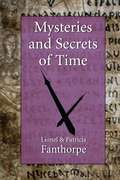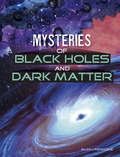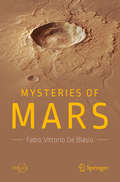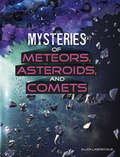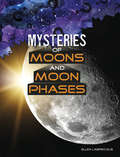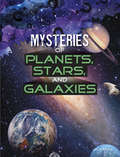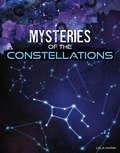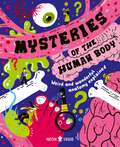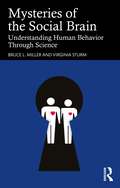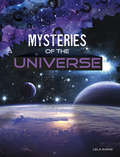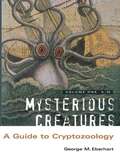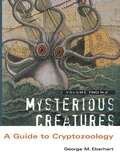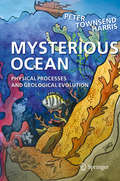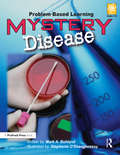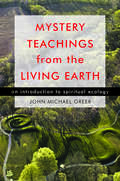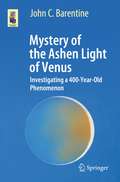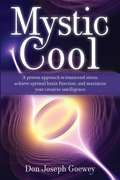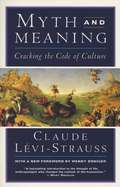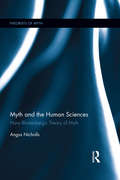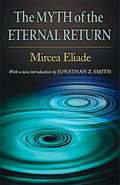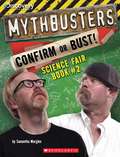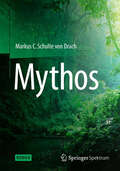- Table View
- List View
Mysteries and Secrets of Time
by Lionel And FanthorpeThis fascinating work begins with a scientific appraisal of time and its relationship with 3D space. It explains in clear, understandable language, the complex theories of such famous men as Newton, Einstein, and Stephen Hawking. Is time infinite, or does it have a beginning and an end? Do Black Holes and White Vortices distort time, or penetrate it? The authors also analyse and evaluate puzzling, well documented reports of time travel and reincarnation, and strange cases of deja vu. Can time travel account for such anachronistic discoveries as a 20th century sparkplug found encased among fossils half a million years old? Finally, the authors bring all the unsolved time-related mysteries together in a unified field theory that suggests an awesome answer to the mysteries of time-travel and reincarnation.
Mysteries of Black Holes and Dark Matter (Solving Space's Mysteries)
by Ellen LabrecqueWhat is a black hole? What is dark matter and what is it made of? How do scientists discover black holes and dark matter if they can’t be seen? What do scientists know about these mysterious parts of the universe and what do they still hope to find out? Budding astronomers will learn the answers to these questions and more!
Mysteries of Mars (Springer Praxis Books)
by Fabio Vittorio De BlasioThis book introduces the reader to the wonders of Mars, covering all aspects from our past perceptions of the planet through to the latest knowledge on its history, its surface processes such as impact cratering, volcano formation, and glaciation, and its atmosphere and climate. In addition, a series of ten intriguing open issues are considered in a more advanced way. These include such thought-provoking questions as What turned off the planet’s magnetic field?, Why are the northern and southern hemispheres so different?, What was the fate of the once abundant water?, and Is there, or was there, life on Mars? Numerous original figures, unavailable elsewhere, reproduce details of images from Viking, CTX, MOC, HiRISE, THEMIS, and HRSC. The book will appeal especially to general readers interested in planetary sciences, astronomy, astrogeology, and space exploration and to students of Earth Sciences and Natural and Environmental Sciences. The higher-level material on the remaining mysteries of Mars will also be of interest to astrogeologists and other researchers.
Mysteries of Meteors, Asteroids, and Comets (Solving Space's Mysteries)
by Ellen LabrecqueWhat are asteroids, comets, and meteors made of? What can scientists do if an asteroid is headed toward Earth? Learn how astronomers prepare for space objects hitting Earth, from tracking them to building asteroid-hunting telescopes. Budding astronomers will learn all about meteors, asteroids, and comets, including the history of asteroids hitting Earth and the differences between space rocks.
Mysteries of Moons and Moon Phases (Solving Space's Mysteries)
by Ellen LabrecqueFull moons in folklore and legends are said to have magic power. Does a full moon really affect our planet and people living on it? Get a closer look at the moons in our solar system, from the known moons to the ones that haven’t been discovered. Budding astronomers will learn all about moons, from Jupiter’s 63 moons to the features of Earth’s moon.
Mysteries of Planets, Stars, and Galaxies (Solving Space's Mysteries)
by Lela NargiDoes life exist somewhere other than Earth? How many planets are outside our galaxy? What happens when stars crash into each other? For a long time, people believed Earth was the only planet in the galaxy. Now we know the universe is much bigger. Budding astronomers will learn all about planets, stars, and galaxies, from what’s already known to what scientists are still hoping to find out.
Mysteries of the Constellations (Solving Space's Mysteries)
by Lela NargiWhat are constellations? Who named them? Where can they be found? Ancient peoples believed constellations held clues to the future. These groupings of stars helped farmers plant crops and sailors find their way home. Budding astronomers will learn all about constellations, including the history of studying the stars, how today’s constellations were named, and how constellations help today’s astronomers.
Mysteries of the Human Body: Weird and Wonderful Anatomy Explained
by Neon Squid Dr. Azmain ChowdhuryA human body book with a twist—discover the science behind the weird and unusual stuff our bodies can do from Dr. Azmain Chowdhury, with illustrations from Daniel Nelson.You know your heart is always beating, your intestines digest your food, and even that your brain is still awake when you’re asleep—that’s no mystery. But why do we get "brain freeze" if we eat ice cream too quickly? And why on earth do we get butterflies in our stomach when we’re nervous? And is it true we can squirt milk from our eyes?!This book focuses on the bizarre things all of our bodies do—including things we don’t understand (looking at you, appendix). Dr. Azmain also asks the burning medical questions we’ve all been wondering about:Why does cilantro taste like soap to some people?How long can we stay awake for?Can our hearts actually break after a romantic break-up? (Asking for a friend).Filled with gross, surprising, and downright terrifying facts, it’s bloated with cool science to impress your friends.
Mysteries of the Social Brain: Understanding Human Behavior Through Science
by Bruce L. Miller Virginia SturmMysteries of the Social Brain describes the scientific underpinnings of human behavior and values. Through the retelling of fascinating clinical stories of people with neurological conditions, this book explores the parts of the brain that allow humans to thrive as social and creative beings. The authors reveal the relevance of our brain circuits to our well‑being—and the well‑being of our societies—and show what happens when changes in our brain circuitry drive changes in empathy, altruism, moral beliefs, and creativity.By integrating perspectives from neurology, psychology, psychiatry, and neuroscience, the stories in this book offer novel insights into the inner workings of the social brain and reveal groundbreaking findings from work in frontotemporal dementia, emotion, and the science of human values. This book showcases the novel discovery that creativity can emerge when there is decline in the brain’s language systems, a finding that highlights the robust, yet underappreciated connections between science and art. Readers will learn about the biological basis of social behavior as well as simple steps that they can take to improve the functioning of their own social brains.Miller and Sturm take us on an engaging dive into the field of behavioral neurology and neuroscience, exploring what we can learn from people with neurological conditions, and revealing the ways that neuroscience can change societies for the better. It will captivate general readers as well as clinicians and scientists who are interested in human social behavior, cognition, and emotion.
Mysteries of the Universe (Solving Space's Mysteries)
by Lela NargiHas the universe always existed? Scientists have looked further into space and discovered the galaxies moving. Were they once closer together? If scientists look far enough, can they discover where our universe started? Budding astronomers will learn all about the universe in this in-depth look at space science.
Mysterious Creatures: A Guide To Cryptozoology, Volume 1
by George M. EberhartIn the hi-tech, industrialised world of the 21st Century, monsters still loom large. Far from being relegated to the realm of myth and legend, mysterious creatures seem to be alive and well today. <p><p>In this, the first of two volumes, acclaimed researcher George M. Eberhart provides a comprehensive list of the creatures that roam our monster-haunted planet. Covering 'A-M', Volume One tackles some well-known beasts as well as more esoteric creatures few will have heard of.
Mysterious Creatures: A Guide To Cryptozoology, Volume 2
by George M. EberhartIn the hi-tech, industrialised world of the 21st Century, monsters still loom large. Far from being relegated to the realm of myth and legend, mysterious creatures seem to be alive and well today. <p><p>In this, the second of two volumes, acclaimed researcher George M. Eberhart provides a comprehensive list of the creatures that roam our monster-haunted planet. Covering 'N-Z', Volume Two tackles some well-known beasts as well as more esoteric creatures few will have heard of.
Mysterious Migrations (Fountas & Pinnell LLI Purple #Level Q)
by Terry Miller ShannonText Elements <p><p> Genre: Expository/Biography <p> Text Structures <p> Main: Chronological Sequence <p> Embedded: Description, Problem/Solution, Cause/Effect <p> Text Features: table of contents, headings, photos, captions, map, sidebars
Mysterious Ocean: Physical Processes and Geological Evolution (Springer Oceanography Ser.)
by Peter Townsend HarrisThis book provides an introduction to ocean sciences that is engaging, evocative and accessible to non-experts interested in marine geoscience, while sparking readers' interest in important unsolved mysteries in marine science. The scope of the book is quite broad, but focuses on the physical ocean and its geological evolution, including the author's experiences working as an oceanographer over the last thirty years. Across ten chapters, the book traces the origins of the ocean from its formation 4 billion years ago, reviews the discoveries of the theory of plate tectonics, the ice ages and the great ocean conveyor, and discusses seafloor features (canyons, seamounts, trenches, abyssal plains, etc.), how they formed and their current environmental issues. The book concludes with a prognosis for the future ocean we might expect with global climate change and other human impacts.
Mysterious Patterns: Finding Fractals in Nature
by Sarah C. CampbellNature's repeating patterns, better known as fractals, are beautiful, universal, and explain much about how things grow. Fractals can also be quantified mathematically. Here is an elegant introduction to fractals through examples that can be seen in parks, rivers, and our very own backyards. Young readers will be fascinated to learn that broccoli florets are fractals—just like mountain ranges, river systems, and trees—and will share in the wonder of math as it is reflected in the world around us. Perfect for any elementary school classroom or library, Mysterious Patterns is an exciting interdisciplinary introduction to repeating patterns.
Mystery Disease: Problem-Based Learning (Grades 5-8)
by Mark A. BohlandA serious illness is sweeping through town. Why are people getting sick? What is the source of this disease? With this problem-based learning unit, students become public health workers as they track down the source of a mysterious illness. Working in teams to solve the real-world problem and present their findings, they experience genuine, higher order learning. Decisions they make affect the outcome of the simulation.The activities combine science, social studies, math, research, thinking, cooperation, and speech skills in one great unit. This guide includes everything you need—teacher's directions and student information in the form of memos and medical reports.This open-ended scenario will draw students into a real-life drama.Allow your students to solve more real-life problems in Crime Scene Detective, Detective Club, Mystery Science, and The Great Chocolate Caper.Grades 5-8
Mystery Teachings from the Living Earth: An Introduction to Spiritual Ecology
by John Michael GreerThe authentic mystery teachings are not about quick fixes or easy answers. They offer something far deeper and more meaningfulùa path of personal transformation in harmony with the cosmos on all its levels, from the ultimate heights of spirit to the fragile and beautiful planet on which we live. In Mystery Teachings from the Living Earth, ecologist and Druid initiate John Michael Greer offers an introduction to the core teachings of the mysteries through the mirror of the natural world.
Mystery of the Ashen Light of Venus: Investigating a 400-Year-Old Phenomenon (Astronomers' Universe)
by John C. BarentineThe “Ashen Light” of Venus—a ghostly emission of light from the night side of our nearest planetary neighbor—is among the last unsolved mysteries of astronomical history. In the four centuries since the phenomenon was first reported, highly reputable visual observers of Venus have recorded seeing the Ashen Light, while others have spent a lifetime searching for it without once being convinced that they ever saw it. Is the Ashen Light a trick of the eye? The result of a defective lens? A real scientific event? Occasional references to the Ashen Light are scattered across the literature, yet no work to date has synthesized these records. This book therefore digs deep into the history of the mystery and our latest attempts to understand it, sifting through the clues that might explain whether it is caused by physics, is conjured up by the eye or brain, or a combination of both. This baffling story will appeal to amateur astronomers, hobbyists, and lay readers interested in joining the debate about one of the most elusive observable phenomena ever recorded in the night sky.
Mystic Cool: A proven approach to transcend stress, achieve optimal brain function, and maximize your creative intelligence.
by Don Joseph GoeweyYou possess the most remarkable system in all of biology, the human brain. You have the power to direct it with the most complex set of processes in the universe, the mind. When you use this creative power consciously, you not only actualize the power to excel in whatever you do, you can direct your experience in ways that make life fulfilling and meaningful. As wonderful as this might sound, for many the journey may be anything but. Every major survey shows that the majority of us are plagued by stress and anxiety, which is toxic to the brain. The new science is clear: transcend stress, regain higher brain function, and the mind lights up with creative intelligence. Mystic Cool shows us how to calmly turn our backs on stress and walk in the direction of the brilliant life we were born to live.
Myth and Meaning
by Claude Levi-StraussIn these five lectures, distinguished social anthropologist offers the insights of a lifetime spent interpreting myths and trying to discover their significance for human understanding. This textbook tries to bridge the gap between myth and science. table end
Myth and the Human Sciences: Hans Blumenberg's Theory of Myth (Theorists of Myth)
by Angus NichollsThis is the first book-length critical analysis in any language of Hans Blumenberg’s theory of myth. Blumenberg can be regarded as the most important German theorist of myth of the second half of the twentieth century, and his Work on Myth (1979) has resonated across disciplines ranging from literary theory, via philosophy, religious studies and anthropology, to the history and philosophy of science. Nicholls introduces Anglophone readers to Blumenberg’s biography and to his philosophical contexts. He elucidates Blumenberg’s theory of myth by relating it to three important developments in late nineteenth- and early twentieth-century German philosophy (hermeneutics, phenomenology and philosophical anthropology), while also comparing Blumenberg’s ideas with those of other prominent theorists of myth such as Vico, Hume, Schelling, Max Müller, Frazer, Sorel, Freud, Cassirer, Heidegger, Horkheimer and Adorno. According to Nicholls, Blumenberg’s theory of myth can only be understood in relation to the ‘human sciences,’ since it emerges from a speculative hypothesis concerning the emergence of the earliest human beings. For Blumenberg, myth was originally a cultural adaptation that constituted the human attempt to deal with anxieties concerning the threatening forces of nature by anthropomorphizing those forces into mythic images. In the final two chapters, Blumenberg’s theory of myth is placed within the post-war political context of West Germany. Through a consideration of Blumenberg’s exchanges with Carl Schmitt, as well as by analysing unpublished correspondence and parts of the original Work of Myth manuscript that Blumenberg held back from publication, Nicholls shows that Blumenberg’s theory of myth also amounted to a reckoning with the legacy of National Socialism.
Myth of the Eternal Return: Cosmos and History
by Mircea Eliade Willard R. TraskThis founding work of the history of religions, first published in English in 1954, secured the North American reputation of the Romanian émigré-scholar Mircea Eliade (1907-1986). Making reference to an astonishing number of cultures and drawing on scholarship published in no less than half a dozen European languages, Eliade's The Myth of the Eternal Return makes both intelligible and compelling the religious expressions and activities of a wide variety of archaic and "primitive" religious cultures. While acknowledging that a return to the "archaic" is no longer possible, Eliade passionately insists on the value of understanding this view in order to enrich our contemporary imagination of what it is to be human. Jonathan Z. Smith's new introduction provides the contextual background to the book and presents a critical outline of Eliade's argument in a way that encourages readers to engage in an informed conversation with this classic text.
Mythbusters: Confirm or Bust! Science Fair Book #2
by Samantha MarglesThis fun follow-up book to the successful MythBusters Science Fair Book is packed with more than thirty brand-new experiments for school and at home.
Mythos
by Markus C Schulte von DrachEine Expedition ins Herz des Dschungels. Eine Reise an den Anfang und das Ende des Glaubens. Eine abenteuerliche Auseinandersetzung mit der Religion und der Evolution. Im Jahr 1539 begegnet der spanische Konquistador Juan de la Torre im Amazonasdschungel dem Teufel. Als fast 500 Jahre später die deutsche Schriftkundlerin Nora Tilly im Indienarchiv von Sevilla auf Dokumente des Spaniers stößt, entdeckt sie Hinweise auf einen Inka-Schatz. Doch bald muss sie feststellen, dass sie nicht die einzige ist, die sich auf den Weg macht, um das Gold zu finden. Die irische Journalistin Brea MacLoughlin reist mit einer Delegation katholischer Geistlicher ebenfalls nach Peru, um ein angebliches Wunder in den Anden zu überprüfen. Zu dieser Delegation gehört auch der junge Priester Arnaud d'Albret, der in Südamerika über eine ihm verbotene Liebe hinwegzukommen hofft. Nach dem gewaltsamen Tod seines Mentors schließt d'Albret sich Nora Tilly an. Auch Brea MacLoughlin folgt der Expedition der Schatzsucher. Im Dschungel Perus entdeckt unterdessen der Biologiestudent Francisco Pérez etwas, das eigentlich nicht existieren dürfte: das fünfzehn Millionen Jahre alte Fossil eines Riesenkrokodils, in dessen Schädel eine Pfeilspitze steckt. Der Versuch, dieses Rätsel zu lösen, führt ihn schließlich mit den Schatzjägern aus Europa zusammen. Doch was die Expedition im Dschungel erwartet, ist nicht nur das Gold der Inka. Tief im Wald stoßen sie auf etwas, das ihr Weltbild in Stücke reißt. ......... "Eine abenteuerliche Melange aus Dawkins' Gotteswahn, Indiana Jones und Jurassic Park. Schulte von Drach gelingt, was Dan Brown nie schaffte: den Leser zu fesseln, ohne seinen Verstand zu lähmen. Absolut empfehlenswert!" Michael Schmidt-Salomon, Philosoph und Schriftsteller, Vorstandssprecher der Giordano-Bruno-Stiftung, Autor von "Jenseits von Gut und Böse" "Wie viel Menschenwerk steckt in der Religion? Im Unterschied zum ätzenden Stil neoatheistischer Gotteswahn-Polemik setzt dieses Buch auf eine Strategie à la Umberto Eco: Der Reigen religionskritischer Überlegungen ist eingepackt in eine Rahmenhandlung, deren Spannung - Science-Fiction und Thriller im besten Sinn - den Leser mitnimmt zu den Etappen der intellektuellen Auseinandersetzung." Christian Kummer, Biologe, Philosoph und Jesuit, Professor an der Hochschule für Philosophie in München, Autor von "Der Fall Darwin" _____ Terra X und Theodizee, Evolution und El Dorado, Schatzjagd und Gottessuche - Markus C. Schulte von Drachs neuer Roman entführt Sie auf eine abenteuerliche Reise um die halbe Welt und zurück bis ins 16. Jahrhundert: Von Sevilla, Kismayoo, Florida und Iquitos aus machen sich seine Helden auf den Weg ins Herz des Amazonas-Regenwaldes. Auf der Suche nach dem legendären Inka-Gold, einem unglaublichen Fossil und ihrem Seelenfrieden stoßen ein französischer Priester, eine deutsche Schatzjägerin, eine irische Journalistin, ein peruanischer Biologiestudent und ein türkischer Kreationist auf die Spuren des Matararo. Doch gibt es dieses Wesen überhaupt? Lassen Sie sich von den Abenteuern genauso fesseln wie von den Auseinandersetzungen über Religion und Wissenschaft, die diesen Thriller so außergewöhnlich machen. Folgen Sie den unterschiedlichen Persönlichkeiten auf ihrem Weg, bis am Ende alle gemeinsam vor einer einzigen Aufgabe stehen: zu überleben.
